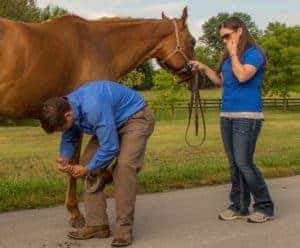
Equine Prepurchase Exams: Not Just Looking for Lameness
Find out what conditions, beyond lameness, a veterinarian might uncover during a prepurchase exam.

Find out what conditions, beyond lameness, a veterinarian might uncover during a prepurchase exam.

Find out what a veterinarian might look for when examining a horse that loses his balance after jumping a fence.

Owner-provided information and a thorough lameness examination can help veterinarians start meaningful investigations into front foot lamenesses.

Learn how these injuries happen, how veterinarians treat them, and tips for preventing them in the first place.

Read about the steps veterinarians and farriers take to identify, evaluate, and treat riding horses’ hoof problems.

Find out how to recognize when a horse is at risk of developing EMS-related laminitis and what you can do to either prevent or manage it so he stays sound.

Can a horse go lame because of extreme hoof cracks and not being trimmed regularly?

Do you suspect your horse is lame? Here we’ll show you how to fine-tune your riding senses to recognize lameness when you’re on your horse.

Discover how coffin bone fractures happen and how to prevent them from becoming career-ending injuries.

Read about common heel conditions in horses and how to address them.

Veterinarians consider MRI the gold standard for diagnosing equine musculoskeletal injuries. Learn more with this visual guide. Sponsored by Hallmarq Veterinary Imaging.

Going barefoot can benefit hoof health, but consider management and physical needs before pulling shoes.

Are horses that develop sepsis-related, supporting-limb, or idiopathic laminitis at a higher risk of developing endocrinopathic laminitis down the road?

Getting to the root of podotrochlosis, one of the most common causes of lameness, is an ongoing process. Learn about risk factors for the disease and how veterinarians diagnose it.

Learn about four common injuries veterinarians see in these athletes, how they diagnose them, and what treatments and rehabilitation methods they use to get horses back to performance.

Because the hooves are integral to soundness, veterinarians and farriers should work together to give lame horses the best prognosis.
Stay on top of the most recent Horse Health news with
© 2022 Copyright Statement dolor sit amet, consetetur sadipscing User Terms, sed diam nonumy eirmod tempor invidunt ut labore et dolore magna aliquyam erat, sed diam voluptua. At vero eos et accusam et justo duo dolores et ea rebum. Stet clita kasd gubergren, no sea takimata sanctus est Lorem ipsum dolor sit amet.
"*" indicates required fields